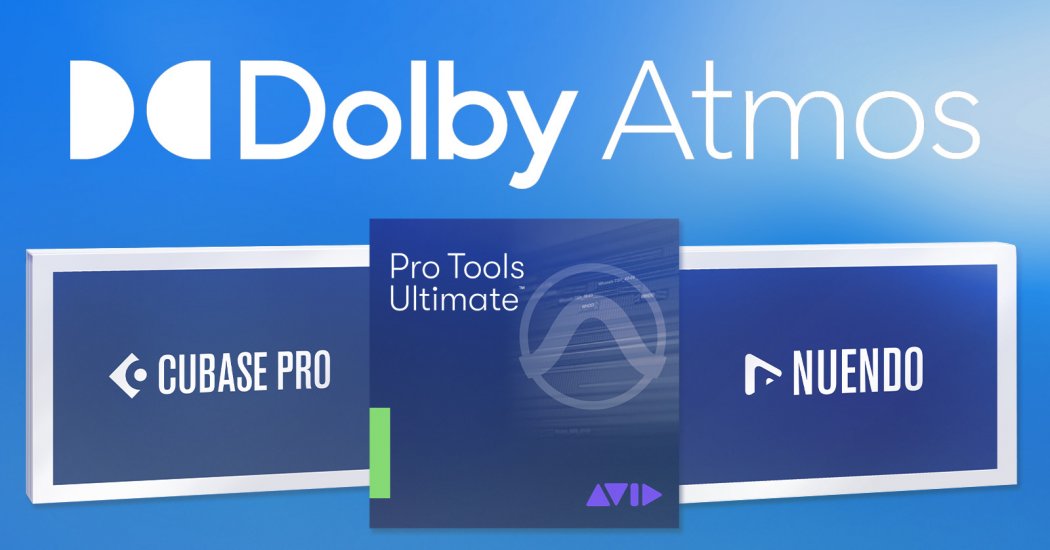
You probably have heard the term “Dolby Atmos” by now. Perhaps you’ve even heard music or watched films in Atmos. But do you have ambitions to create, mix, or master your own content in this format? If you do but you don’t know where to start, then this article is for you. Let’s discuss what DAWs currently harness the power of Atmos the best so you can take any of your audiovisual projects to new creative places.
- Does Dolby Atmos Actually Matter?
- Okay, but Why Does Dolby Atmos Matter?
- I Hasten to Mention
- Avid Pro Tools Ultimate
- Steinberg Nuendo 12 & Cubase Pro 12
- Blackmagic Design DaVinci Resolve Studio
- Apple Logic Pro X
- Other Potential DAWs
Does Dolby Atmos Actually Matter?
The short answer is yes. The audio world has been buzzing (and at times, raging) about “immersive audio” for several years now. At the moment, the general consensus appears to have somewhat solidified into the idea that immersive audio formats like Dolby Atmos make perfect sense for films and video games but little to no sense whatsoever for music production. However, like most things in life, the reality of the situation is a bit more nuanced.
I recently attended an immersive audio event in Nashville hosted by Mix magazine. This event was focused almost entirely on immersive audio for music, with a variety of panels covering such topics as producing, mastering, and monitoring immersive music. Panelists included industry leaders whose names you’re sure to recognize if you’re a music producer or mix engineer: Vance Powell, Mills Logan, F. Reid Shippen, Jeff Huskins, Jeff Balding, Chuck Ainlay, and more. My head is still spinning from all the information thrown at me that day, but one thing that the event made very clear for me (and something that every panelist agreed on) was this: Immersive audio, even for music, is here to stay. It’s not just a passing fad, and every serious audio professional needs to start becoming comfortable working with it.
Okay, but Why Does Dolby Atmos Matter?
I’m glad you asked! Immersive audio formats (of which Dolby Atmos is the current front runner) matter for a couple of reasons. Firstly, many platforms now actually require Atmos deliverables. Netflix and Amazon Prime, for example, have been requiring Atmos mixes for their shows for a few years already. This matters for musicians because licensing and syncing your music to shows on Netflix and other such platforms is a hugely lucrative opportunity. It’s true that many music mixes at the moment get delivered in stereo files, but I suspect that will change at some point sooner rather than later. If you’re unable (or unwilling) to have your music mixed in Atmos, then you may be potentially missing out on a fantastic source of revenue in the near future.
Also, anyone looking to get their music on Apple Music (and actually have it sound good) must be able to deliver a mix of their music that’s convertible into Apple’s proprietary Apple Spatial Audio format. This inevitably means that they need to be able to deliver an ADM file — in other words, an Atmos mix. Love it or hate it, Apple Music is undeniably one of the best streaming services when it comes to paying artists for streams, so aspiring artists would do well to get their music on this platform.
Finally — and this is just my opinion — immersive audio simply sounds awesome. Again, it really stands out for films and video games, but even for music, the potential for sound quality and creative mix decisions is just incredible. I know it sounds cliché and/or hyperbolic, but the first time I heard a great Atmos mix in a well-treated Atmos-equipped mixing room, my jaw literally dropped. Plus, while it may seem daunting, mixing tracks in 12 channels as opposed to only two is a lot of fun. Trying to get a bunch of tracks to sit well together in a stereo mix can sometimes feel like trying to shove the star peg into the square hole, but when you’ve got 12 (or more) channels to work with, everything suddenly has much more room to breathe! Even if you have no aspirations of delivering final immersive mixes, I still suggest you try playing around with your projects in Atmos or some other immersive audio format. You may be surprised at how much you enjoy it.
I Hasten to Mention
Stereo’s not going anywhere, folks! Immersive audio formats aren’t going to “replace” stereo anytime soon, if ever. As just one example as to why that is, the single biggest moneymaker for indie artists — as far as merchandise goes — is vinyl, and you can only cut a vinyl record from a stereo master file. There’s also the fact that many people of certain age groups have grown up listening to stereo, so immersive audio formats simply sound weird to them. On the flip side of that coin, thanks to headphones and formats like Apple Spatial Audio, there are also upcoming generations of people who have been regularly listening to immersive audio mixes (oftentimes without even realizing it), so stereo mixes possibly sound strange to them! Rather than viewing “stereo” or “immersive” as being locked in some colossal battle of good and evil, think of them both simply as formats that professional audio engineers will be expected to understand and be able to deliver mixes in. With that thought in mind, if you’d like to begin your journey into the Wild West that is immersive audio, then here are the DAWs you should be looking at.
Avid Pro Tools Ultimate
This might go without saying, but Avid Pro Tools Ultimate is currently the head honcho for all things immersive audio — especially since the recent 2023.6 update introduced new 9.1.6 and 7th Order Ambisonics track widths and 96kHz Dolby Atmos ADM support. Its surround sound monitoring capabilities got a huge boost as well, with new 5.1 and 7.1 stereo configurations and new 5.1.4 and 7.1.2 immersive configurations for the Avid Pro Tools Carbon audio interface.
Note that for your mixing room to be certified and licensed by Dolby as “officially” having Atmos capabilities, you need to have at least a 7.1.4 configuration (with a ceiling height of at least eight feet). So, if that’s the route you want to take, then the Avid Pro Tools MTRX II audio interface with Thunderbolt 3 module would be more to your liking.
Steinberg Nuendo 12 & Cubase Pro 12
In early 2021, Steinberg’s Nuendo 11 became the first DAW in the world to have an onboard, fully integrated Atmos renderer. This enabled Nuendo 11 users to work in Atmos without needing to purchase Dolby’s own Atmos Production and Mastering Suites separately. This implementation has only been honed these last couple of years, and not only is it working better than ever inside Steinberg Nuendo 12, but it’s also now onboard in Steinberg’s other professional DAW, Steinberg Cubase Pro 12. Some other very cool features supported by both DAWs include onboard head tracking, Ambisonics support, and support for Immerse, which allows you to create your own personalized Head Related Transfer Function. Nuendo 12 edges out Cubase Pro 12 on the whole for immersive audio content, however, due to having a more robust set of features. Some of these extra goodies include external Dolby Atmos Renderer support, a greatly improved bed count (64 vs. one), ADM import, Auro-3D support, and more.
Blackmagic Design DaVinci Resolve Studio
Blackmagic Design DaVinci Resolve is well-known for its video editing capabilities, but audio professionals should pay attention to its performance in that arena as well. The free version of DaVinci Resolve, with its Fairlight audio panel, is already very powerful on its own — its ability to have 2,000 tracks is just one example of its firepower. DaVinci Resolve Studio only ups the ante by including — among many other advanced features — native support for Dolby Atmos, Auro-3D, and other spatial audio formats all the way up to a 22.2 configuration. Sweetwater sells the Blackmagic Design DaVinci Resolve Studio color correction and video post-production suite dongle on its own, but it also comes bundled with many Blackmagic Design products to give you even more bang for your buck, such as this Blackmagic Design DaVinci Resolve editor keyboard, plus many of the company’s excellent video cameras.
Apple Logic Pro X
Sweetwater doesn’t actually carry Apple Logic Pro X, so you may be wondering why I’m recommending it. Because of the current prevalence of Apple and its various products and services, Logic Pro X is suggested by many industry professionals at least as a side DAW for monitoring your immersive mixes, even if you already have a preferred primary DAW. At present, more than 90% of all listeners exposed to immersive audio aren’t listening to it on huge home theater systems; they’re listening on headphones, like the Apple AirPods Pro or the wireless, over-ear Apple AirPods Max Bluetooth headphones, and through music streaming services, like Apple Music, which is the largest streaming service in the US as of this article’s writing (narrowly edging out Spotify by approximately two million subscribers). This means that being able to monitor your immersive mixes in Apple’s proprietary Apple Spatial Audio format can be very helpful — and for that, Logic Pro X is the only ticket in town.
Other Potential DAWs
Frankly, Dolby’s website can be a little difficult to navigate. On one page, the website specifies that while the above DAWs all have integrated immersive panners, other DAWs have also been confirmed as usable with Atmos, provided that you download and install the Dolby Atmos Renderer and the Dolby Atmos Music Panner. Visiting other pages on the site, however, will reveal that these are actually both available now in a single product: Dolby Atmos Renderer v5.0. This application blends Dolby’s Atmos Production Suite and Atmos Mastering Suite together into a single package that is available from the Avid store for $299, but they also offer a generous 90-day free trial period.
There are a couple of things worth noting. Firstly, the only DAW that I was able to find mentioned specifically by name as having been officially confirmed by Dolby for use with this workflow was Ableton Live. Cockos REAPER and Adobe Audition are also usable, but they require a few creative work-arounds.
Secondly, the Dolby Audio Bridge is only supported on Mac. This means that Windows users will need to use a separate workstation to run the Renderer application. Dolby has qualified numerous workstations to work for this purpose, including our very own Sweetwater Custom Computing CS400 4U professional audio and video production workstation.
| Mac | Windows | |
| Dolby Atmos Renderer on same computer as DAW? | Yes | No* |
* Dolby Audio Bridge, which is necessary to route audio from a DAW to Dolby Atmos Renderer on a single computer, is available for macOS only. Customers running Dolby Atmos Renderer on Windows must run on a separate computer from their DAW and use a hardware solution to route audio to/from the DAW.
Ready to Take the Leap?
Immersive audio is still developing, with standards and practices that are presently being ironed out by industry executives, audio engineers, musicians, and consumers. That said, it’s an incredibly exciting development — one that I feel can take your music and any other audiovisual projects to new creative places. As always, Sweetwater is at the forefront of pro audio and music industry developments. Our Sweetwater Sales Engineers are among the first people in the world to learn about new emerging audio technologies and how to use them. So, if you ever have any questions about Dolby Atmos, Apple Spatial Audio, or anything else related to immersive audio, then please feel free to give Sweetwater a call at (800) 222-4700!


